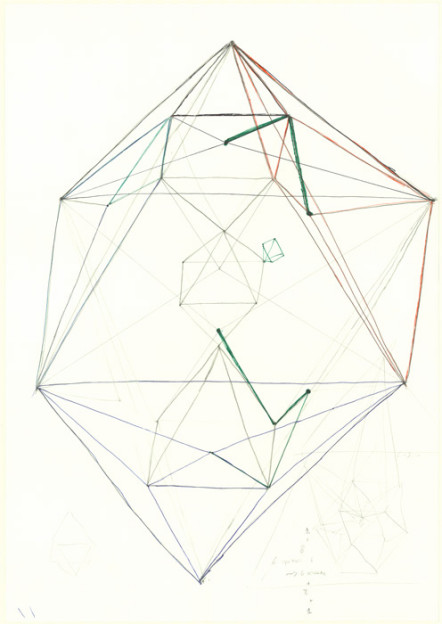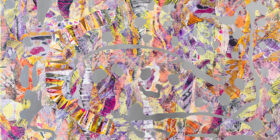Drawing as a way of knowing
“My current work is about drawing as a way of knowing and about knowing about drawing as a way of knowing”. Gemma Anderson is an artist, researcher and university lecturer whose practice is at the interface of art and science. She has worked on different collaborative projects with mathematicians and natural scientists and has recently completed her PhD ‘Drawing as Epistemology for Morphology’. She is currently artist in residence for the Northern Ireland Science Festival (2016) and also at Imperial College (Mathematics department).

Gemma Anderson: Isomorphogenesis No.13
Richard Bright: Can we begin by you saying something about your background?
Gemma Anderson: I grew up in Belfast city. At school I studied art and biology and kept bringing the biological into my artwork. I was frustrated by the text-heavy teaching style in A-level biology, which put me off conventional scientific education but also provided an opportunity for me to begin to approach biology in my own way. Since then I have used drawing as my ‘way in’ to investigate phenomena that are studied by biological and other scientific disciplines. I have generated my own questions about natural phenomena during art school (University of Ulster, Falmouth College of Art, Royal College of Art) and gradually built up a stronger relationship with scientists and scientific institutions which led to a number of collaborations and residencies (for example Imperial College, Wellcome Trust, Natural History Museum).
My current work, follows on from my PhD research about drawing as a way of knowing and about knowing about drawing as a way of knowing. I work with the theme of Morphology and Drawing as parallel dynamic processes, exploring intuitive and experimental drawing methodologies. My key questions are about: how can we understand form and formative processes through drawing and, what contribution can the artist make – representationally, analytically, in terms of interpretation and critique– to the advancement of knowledge of the natural world through drawing, especially drawing effected in collaboration with scientific practices and instrumentation? As an artist and researcher, my practice places artistic research in a scientific context through collaborations with scientists and institutions. This interdisciplinary exchange, led by drawing and dialogue, stimulates questions about ways to integrate scientific research, museum and laboratory practices into artistic practice and modes of display.

Gemma Anderson: Isomorphogenesis No.1
RB: Over the past twenty years or so, anthologies, conferences, dedicated degree drawing courses, research papers, have proliferated. They all speak of the ‘expanded field’ of drawing, expanded not only in what can be counted in as drawing, but also in how we can think about drawing. Why do you think there has been such an upsurge in interest in drawing?
GA: I believe this recent resurgence highlights contemporary interest in drawing as an important part of visual literacy and as an epistemological and creative tool. The field of ‘Drawing Research’ has emerged in recent years, through a number of exhibitions, conferences and publications, as an active strand of artistic and ontological interest.
In Writing on Drawing – essays on drawing practice and research (2012) Steve Garner argues for the value of drawing research to communities beyond the art world, namely the scientific and cultural: ‘drawing research presents a powerful opportunity to demonstrate the ability to generate new knowledge about the visual and to communicate this through the visual’ (Garner, 2012:15). Garner’s view, like John Berger in Ways of Seeing (Berger, 2009), challenges the assumption of the supremacy of the written word in visual research.
Drawing is also growing as a subject in its own right, with BA Drawing courses now being offered in the UK. In line with this development, drawing has also become a focus for contemporary art exhibitions. For example, the recent exhibition and symposium ‘A Call for Drawings’ is a project, exhibition and symposium curated by Klaas Hoek that selects drawings from artists, scientists and other professionals for an interdisciplinary research project investigating the role of visual thinking in cognitive and creative processes. This ‘call for drawings’ can be understood as analogous to the practice in the academic world of ‘a call for papers’, as such recognising drawing as an epistemological tool in scientific and technological disciplines through sketches, maps, drafts, diagrams and other kinds of drawings. Hoek sees drawing as essential to the understanding of problems and the communication of thoughts towards their solutions, saying:
When probing into the unknown, drawing is an ideal tool because drawing is thinking, pointing; it makes things present and puts them at a distance, it is a mode of inquiry. Drawing can represent the seen and present the unseen, the known and the unknown (A Call for Drawings, 2015).
Journals investigating drawing have also emerged over recent years, most recently Drawing Research Theory and Practice (DRTP) (Intellect Ltd) which published its first volume in 2015. Key topics explored by DRTP include drawing as an experimental practice, as research, as representation and/or documentation, drawing as process or as performance, and drawing as an interdisciplinary practice, while taking into account the diversity of its practical, theoretical and physical expressions.

Collaborative Drawing: Drawing an Octahedron in the Fourth Dimension, Graphite on Paper (Gemma Anderson and Alessio Corti, 2013)

Gemma Anderson and Professor Alessio Corti (imperial college)-
RB: Collaboration is an important aspect of your work. Why is this? What role does drawing play?
----------------------------------------------------
The rest of this article is reserved for members only. If you have a subscription, please sign in here. Otherwise, why not Subscribe today?
Get the Full Experience
Read the rest of this article, and view all articles in full from just £10 for 3 months.



No comments yet.